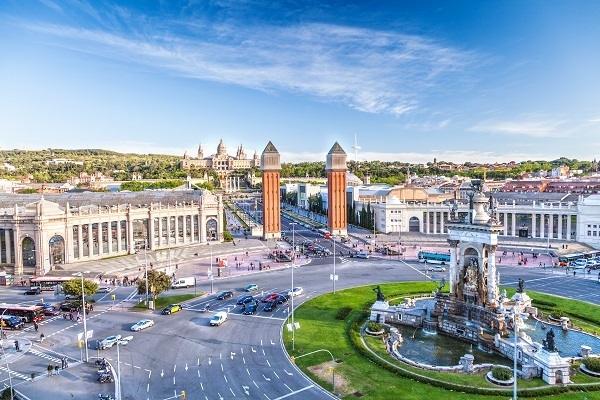Barcelona is not just about visiting the monuments that appear in all tourist guides. The neighborhoods of Barcelona are also an important part of the tourist attraction of the city.
During the end of the course trip, you will visit the most visited monuments, you will make cultural visits and you will learn all about Gaudi’s modernist architecture. But in this city it is important to immerse yourself in its atmosphere, walk through its streets and let yourself be carried away by the hustle and bustle and the life of the city. We tell you in this new article what are the most important neighborhoods of Barcelona and why you should discover them all.
The neighborhoods of Barcelona represent 100% each and every one of the environments that coexist in the city: the modernity of the Eixample, the multiculturalism of the Raval, the bohemian spirit of the Born, the antiquity of the Gothic Quarter, the popular neighborhood of Gràcia with its wide range of stores of all kinds, the art of Poblenou, the hill full of secrets of Montjüic. If you want to discover the unique sides of this city on your end-of-year trip to Barcelona, you will have to see them all.
The Gothic Quarter
El Gòtic is the center of the Historic Center of Barcelona. The Gothic Quarter, or Barri Gotic, is a charming neighborhood with narrow medieval streets lined with trendy bars, pubs and Catalan restaurants. A good recommendation that we can make when visiting this neighborhood is to let yourself be carried away by its streets, improvising your walk. Start by walking down La Rambla, beautiful and bustling, and get lost in the medieval streets and squares of the old town. To admire the city’s architecture, go to Sant Jaume square and visit the two government buildings, the Renaissance palace of the Generalitat and the neoclassical facade of the Ajuntament. These are the must-see sights of the Gothic Quarter, one of Barcelona’s most important neighborhoods:
- Barcelona Cathedral (la Seu) and Diocesan Museum.
- King’s Square
- Sant Jaume Square and City Hall
- Bishop’s Bridge
- Santa Maria del Pi Cathedral and its square
- Jewish Quarter
The Eixample
Geometrically composed in the form of a grid, this district is the center of the city and the one with the largest number of monuments and sites of interest, and it is the shopping area. Once you leave the historic district, the narrow, labyrinthine streets are left behind, and the Eixample gives way to wide, grid-like avenues. In 1855 in Barcelona he opened a competition for an urban expansion project, to satisfy the needs and demand for housing, considering that the city needed to expand. It was promoted by the central government with Ildefonso Cerdá’s plan, based on a regular scheme made up of squared blocks.
The Eixample is famous for being one of Barcelona’s most dynamic districts. Three of Barcelona’s most important thoroughfares run through it: Passeig de Gràcia, Gran Vía and Avinguda Diagonal. This neighborhood is home to many of the most important attractions of the city such as the Sagrada Familia, Casa Batlló or La Pedrera.
Montjuïc
The mountain of Montjuïc should be visited on your end-of-year trip. It is full of fountains, parks and gardens making it the perfect place for a picnic. Here you will also find the Fundació Joan Miró, which is impressive for its building and collection. You will also discover the Magic Fountain at Montjuïc, which has nightly light and music shows during the high season. Montjuïc is characterized by the fabulous views of the city that you get when you climb to the top of the mountain.
This mountain has been used since ancient times as a military lookout post, and Montjuïc mountain is the only important elevation in Barcelona apart from Tibidabo. The works carried out for the Universal Exhibition of 1929 and the Olympic Games of 1992 have made Montjüic a very interesting and complete area for a good cultural visit on a school trip.
- Magic Fountain of Montjüic.
- Castle of Montjüic.
- Spanish Village
- Olympic Ring of Montjüic.
- National Museum of Art of Catalonia.
- Joan Miró ation
- Botanical Garden
El Born
This is one of the places with the most leisure and cultural offer in the city: architecture, gastronomy, art, fashion, restaurants, etc. Its uniqueness lies in its cobbled streets, where you can still perceive the medieval structures, in perfect balance with hundreds of alternative and fashionable stores and stores. Just strolling through its streets is, in itself, a great attraction of the city, knowing its vintage clothing stores and tapas bars. One of the most authentic corners of the neighborhood is the Santa Caterina Market, divided into three floors, and retaining its original charm. Here is a short list of the places you should visit while passing through one of the most important neighborhoods of Barcelona:
- Palau de la Música Catalana
- Santa Catarina Market
- Picasso Museum
- Born Market, now the Cultural Center
- Santa Maria del Mar Basilica
- Sant Pere Church and Square
And if you continue walking along Sant Pere you will reach the Arc del Triomf of Barcelona and its beautiful Ciudadella Park, where the school group can stroll, rest in their free time and improvise a small picnic.
The Raval
El Raval is an interesting and exciting area of Barcelona. This multicultural neighborhood is unique with food stores of all kinds, traditional bars and numerous squares that make it a must-see area. It is a neighborhood full of life, during the day and at night. In this neighborhood let yourself be carried away by its vitality and its mix of cultures, and immerse yourself in its atmosphere until you become part of it. Here are two of the most famous markets in Barcelona: La Boqueria and Mercat Sant Antoni. The first one is much more touristic and colorful, and the second one much closer, but they both have a unique style and authenticity. Do not miss these places in this authentic neighborhood:
- Boqueria Market
- Sant Antoni Market
- Rambla del Raval
- MACBA and CCCB
- Liceu Theater
- Old Hospital de la Santa Cruz
- Marítim Museum
- Columbus Statue
Gràcia Neighborhood
The Vila de Gràcia is one of the most popular and active neighborhoods in Barcelona, a center of leisure, culture and gastronomy. Gràcia was originally an independent village until the end of the 19th century and even today its community is small and closed, with a lot of charm. With narrow streets and few vehicles, Gràcia has a small-town vibe. There are many squares full of terraces and good atmosphere that characterize the neighborhood of Gràcia, along with neighborhood markets and all kinds of local stores.
- Plaza del Sol
- Casa Vicens
- Parc Güell
- Plaza de la Vila de Gràcia
La Barceloneta
Fishermen began to settle in this area of the city in 1754 due to its proximity to the sea, forming the current neighborhood of La Barceloneta. Although it has acquired a modern look, today La Barceloneta still retains its special charm and family atmosphere. The streets of Barceloneta are very pleasant and peculiar; narrow alleys full of old buildings, churches and some shops that have preserved their decoration for almost 200 years. These are the main places of interest in the area:
- Torre de les Aigües
- Viewpoint of the W Hotel on the beach
- Port Vell
- Museum of the History of Catalonia
- Maremagnum
Barceloneta Beach
At Barceloneta Beach it is possible to take the cable car to the Mirador de Miramar and enjoy views of the harbor.
You may also be interested in:
What is the ideal age to attend a summer camp?
Education and values in summer camps.
Summer Camps in Avila, is it worth attending?
The Advantages of summer camps for children of employees.
Best multiaventura camps in Villar Santander.
The history of summer camps and children’s camps in Granada.

